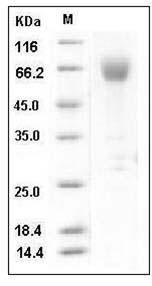-
Product Name
Mouse ICAM-2/CD102 (Fc Tag) recombinant protein
- Documents
-
Description
ICAM proteins are ligands for the leukocyte adhesion protein LFA-1 (integrin alpha-L/beta-2). ICAM2 may play a role in lymphocyte recirculation by blocking LFA-1-dependent cell adhesion. It mediates adhesive interactions important for antigen-specific immune response, NK-cell mediated clearance, lymphocyte recirculation, and other cellular interactions important for immune response and surveillance.
-
Protein name
Intercellular adhesion molecule 2
-
Protein short names
ICAM-2; ICAM2; RP23-418O11.10-001; CD102; LY-60
-
Uniprot ID
P35330
-
Gene Name
Icam2; Icam-2
-
Source/Expression Host
Human Cells
-
Expression Plasmid/cDNA
A DNA sequence encoding the mouse ICAM2 (NP_034624.1) extracellular domain (Met 1-Gln 222) was fused with the Fc region of human IgG1 at the C-terminus.
-
Protein Species
Mouse
-
Molecular weight
The secreted recombinant mouse ICAM2/Fc is a disulfide-linked homodimeric protein. The reduced monomer comprises 444 amino acids and has a predicted molecular mass of 50 kDa. As a result of glycosylation, the apparent molecular mass of rm ICAM2/Fc monomer is approximately 60-70 kDa in SDS-PAGE under reducing conditions.
-
Purity
> 93 % as determined by SDS-PAGE
-
Activity
Measured by the ability of the immobilized protein to support the adhesion of PMA stimulated HSB2 human peripheral blood acute lymphoblastic leukemia cells. When cells are added to mouse ICAM2 coated plates (12.5 μg/ml, 100 μl/well), approximately 25-40% will adhere specifically.
-
Validations

Mouse ICAM-2 / CD102 Protein (Fc Tag) SDS-PAGE
Related Products / Services
Please note: All products are "FOR RESEARCH USE ONLY AND ARE NOT INTENDED FOR DIAGNOSTIC OR THERAPEUTIC USE"
